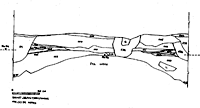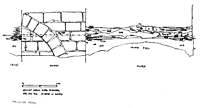
Archaeological Evidence
→ Material Culture: Sample Finds
→ Tile Inventory
→ Coin Inventory
→ Skeleton Inventory
Archaeological evidence includes not only the material (pottery, tiles, human and animal bone, etc.) revealed in excavation, but also the larger stratigraphic and architectural context of those objects. (See Stratigraphy). An archaeological approach denotes attention to material culture within the context of its deposition and discovery.
Stratigraphy
Human occupation of any site over time results in the gradual build up of layers (strata) of the detritus of that human presence including everything from garbage to buildings. Such strata accumulate over time and reflect the “history” of the occupation of the site. That is, the lower layers were deposited first and are, in consequence, older chronologically. Stratigraphic analysis is the archaeological evaluation of the significance of the build-up of strata to determine the temporal sequence of material culture within stratified (or sealed) deposits. Material that is found within the same stratigraphic layer has the same date of deposit (though not necessarily the same date of manufacture). Archaeologically deposited finds are thus dated in relative rather than absolute terms, i.e., objects in an upper layer are later (in date of deposit) than those in the layer below, and earlier than those in the layer above.
Excavations
Field reports from 1994-2002 are available in our Resource Bank.






 This web site was supported by a grant from the National Endowment for the Humanities.
This web site was supported by a grant from the National Endowment for the Humanities.